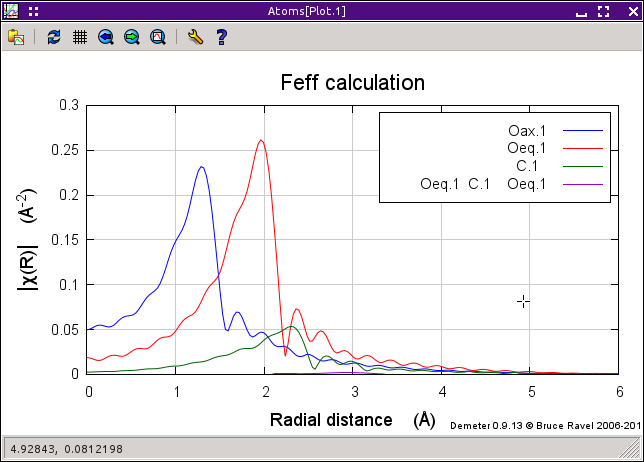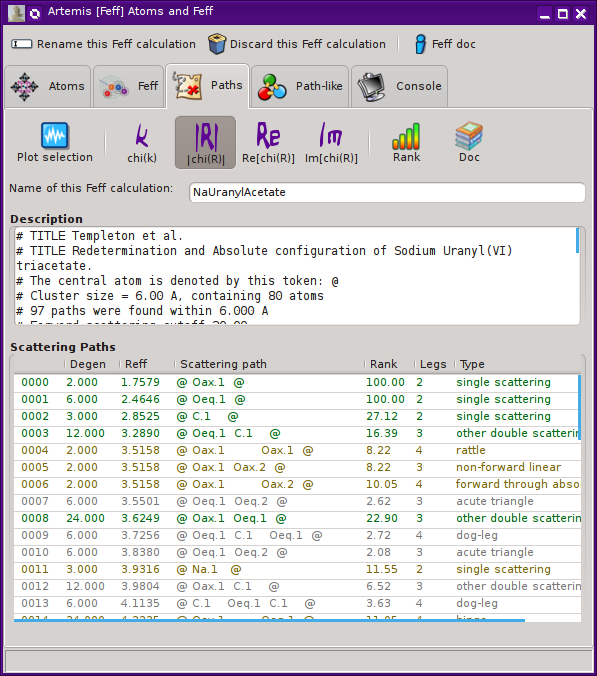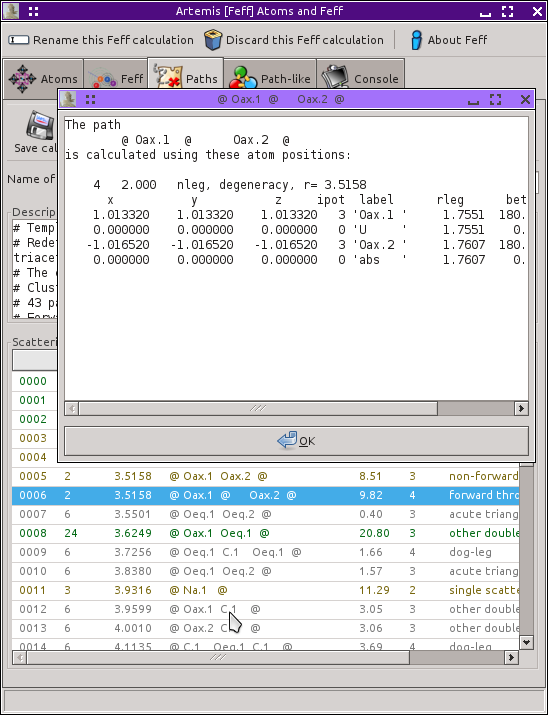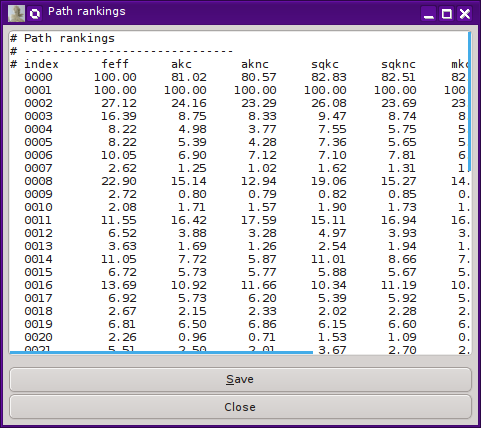The Paths tab
When you click the “Run Feff” button on
the FEFF tab, the FEFF calculation is run. Once finished, a
succinct summary of the calculation is displayed on the Paths tab.
Some statistics about the FEFF calculation are shown in the
Description text box. Below that is the summary of the paths found in
the FEFF calculation. This summary is presented in the form of a
table. Each row describes a scattering path. The columns contain the
following information:
The first column shows a path index, similar to the index that
FEFF uses when run by hand from the command line.
The second column shows the degeneracy of the path.
The third column
shows its nominal path length, Reff. That is value that will be
used in any
path parameter math expression
containing the
reff token.
The fourth column shows a simple view of the scattering path. The
@ token represents the absorber, thus
appears as the first and last token in each description. The tokens
representing the scattering atoms are taken from the tags on the
FEFF tab. You can change the absorber token by setting the
♦Pathfinder → token
configuration parameter.
The fifth column contains the rank of the path. This is an attempt
to predict how important of each path will be to your fitting model.
Paths with large spectral weight have a large rank and paths with
little spectral weight have small rank. Highly ranked paths are
colored green, mid-rank
paths are colored yellow,
and low-rank paths are grey.
Don't put too much faith in this assessment of importance. You
should explicitly check all paths to decide if they should be included
in a fit.
The sixth column gives the number of legs in each path.
The final
column is a simple explanation of the shape of the scattering
geometry.
The rows in this table are selectable by mouse click. Left clicking
on a row selects that row. Control clicking on another row adds it to
the selection. Shift clicking adds to the selection all rows between
the one clicked upon and the previously clicked upon row.
Much of the functionality of this page rests upon the set of selected
paths. Most importantly, selecting paths is the first step to using
paths in a fitting model. This will be explained in the
next chapter.
At the top of the page is a bar of buttons used to perform tasks
specific to the path list. The “Doc”
button will open a browser displaying this documentation for the
interpretation page. The “Rank” button is
described below. The remaining buttons are related to making plots of
the selected paths.
Polarization
If FEFF has been run considering linear polarization, the path
list may be considerably longer. The degeneracy checker in the path
finder calculation will recognize the effect of polarization on path
degeneracy. Paths with common outgoing and incoming angles of the
photoelectron with respect to the specified polarization vector will
be treated as degenerate. Paths which would be degenerate in the
absence of polarization, but which have distinct outgoing and/or
incoming angles will be presented as separate paths in the path list.
When the polarization calculation is performed, the outgoing and
incoming angles will be displayed in
“Scattering path” column (although you may
need to widen the column by clicking on and dragging the little
vertical line that separates the
“Scattering path” and
“Rank” columns in the header row).
Also, when dragging a path onto the data page, the angles out and in
will be displayed in the path geometry box on the
path page.
Optionally, the angles can be displayed in the path list label by
setting the
♦Pathfinder → label
configuration parameter appropriately.
Low ranking paths are, by default, not displayed in the paths list.
In a polarization calculation, typically, paths close to or at 90
degrees in either angle will have very small amplitude and so will not
be displayed in the path list. This behavior of suppressing
low-ranking paths can be controlled by setting the
♦Pathfinder → postcrit
configuration parameter. Setting it to 0 will cause all paths, even
the right angle ones, to be displayed in the paths list.
 FEFF's ELLIPTICITY keyword is not supported at this time.
That means the trick of modeling
“polarization in the plane” is not yet
supported by ARTEMIS.
FEFF's ELLIPTICITY keyword is not supported at this time.
That means the trick of modeling
“polarization in the plane” is not yet
supported by ARTEMIS.
Path plotting and path geometry
 This is a plot of paths from the raw FEFF calculation. In this
example, the first three single scattering paths from the sodium
uranyl triacetate calculation were selected along with a low-rank
multiple scattering path. Then the “Plot
selection” button was pressed. In this plot, we see that the three
single scattering paths are, indeed, quite large. The multiple
scattering path can barely be seen on this scale. It truly is a low
importance path.
This is a plot of paths from the raw FEFF calculation. In this
example, the first three single scattering paths from the sodium
uranyl triacetate calculation were selected along with a low-rank
multiple scattering path. Then the “Plot
selection” button was pressed. In this plot, we see that the three
single scattering paths are, indeed, quite large. The multiple
scattering path can barely be seen on this scale. It truly is a low
importance path.
The meaning of a “raw” FEFF calculation
is that it is displayed as χ(k) with S²₀ set to 1.0 and each
of E₀, ΔR, and σ² set to 0. A plot of χ(R) for
the “raw” FEFF calculation, then,
displays the Fourier transform of χ(k) parameterized with those
values.
It is, therefore, very quick and easy to examine the results of a
FEFF calculation. The other four buttons are used to select how
the plot of paths is made. The options are χ(k), |χ(R)|,
Re[χ(R)], and Im[χ(R)]. The k-weight selected in the Plot
window is used to make the plot of paths.
Right clicking on an entry in the paths list will post a menu. The
first item on the menu opens a dialog window with more details about
the geomtery of the selected scattering path. In the following
figure, the selected path (0006) was right-clicked on, opening the
dialog depicted below.
The other context menu options are used to set the path select on the
basis of distance, ranking, or scattering geometry. These options are
useful for selecting groups of paths to drag and drop onto the Data
window.
The contents of the path interpretation can be filtered after running
the FEFF calculation by setting the
♦Pathfinder → postcrit
parameter. By default, it is set to 3, which means that only paths
with a ranking above 3 will be displayed in the path interpretation.
Resetting this parameter allows you tune how many paths get displayed
after the calculation.
Path ranking
FEFF provides a crude evaluation of the importance of each path
called the “curved wave importance factor”.
This is computed as a very sparse – computed at four points
between 0 Å⁻¹ and 20 Å⁻¹ – trapezoidal integration of
|χ(k)|. This amplitude is then expressed as a percentage
with the largest path having an amplitude of 100.
There are a few shortcomings of FEFF's amplitude factor.
First, the percentages are computed serially. So the frist path is
always given as 100%. If a subsequent path is larger than the first
path, it, so, will be given as 100%. All following paths will be
scaled to size of the later path. This is somewhat confusing.
Second, the integration is very sparse. This made sense back in the
mid-90s, when computers were slower and had less memory. But it means
the amplitude is not very accurate.
Finally, the integration is over a much wider range in k-space than is
typically measured in a real experiment. It would make more sense to
evaluate a measure of the importance of a path over a range in k that
is expressed in a real measurement or, at least, a range that is more
typical of a normal experiment.
To this end, ARTEMIS offers a variety of new ways to rank the
importance of a path. Some use χ(k) and some use χ(R) of the
paths. All are evaluated over a restricted range in k or R. By
default, the range in k is 3 Å⁻¹ and 12 Å⁻¹ and in R it is 1
Å and 4 Å. All are evaluated using the full k or R grid
which is used internally. Some consider k-weighting.
They all have funny acronyms:
-
akc
-
This is the sum over the k-range of the absolute value of k·χ(k).
-
aknc
-
This is the sum over the k-range of the absolute value of
kn·χ(k) where the plotting k-weight is used for n.
-
sqkc
-
This is the square root of the sum over the k-range of the square of k·χ(k).
-
sqknc
-
This is the square root of the sum over the k-range of the square of kn·χ(k)
where the plotting k-weight is used for n.
-
mkc
-
This is the sum over the k-range of k·|χ(k)|.
-
mknc
-
This is the sum over the k-range of kn·|χ(k)|
where the plotting k-weight is used for n.
-
mft
-
This is the maximum value of |χ(R)| within the R-range
where the plotting k-weight is used for the Fourier transform.
-
sft
-
This is the sum over the R-range of |χ(R)|
where the plotting k-weight is used for the Fourier transform.
These new ranking criteria tend to do a better job of correctly
predicting which paths are important to a fit. That's a good
thing. The bad thing is that they take quite a bit longer to compute
than simply relying on FEFF's amplitude ratios.
The full suite of options are provided in order to replicate the
analysis shown in the paper by K. Provost, et al. The
“akc” and “aknc”
choices tend to be reliable.
You can select which criterion to use on the interpretation page by
setting the
♦Pathfinder → rank
configuration parameter to “feff” or to one
of the acronyms above.
You can compare the evaluations of the ranking criteria by pressing
the “Rank” button in the toolbar. This
calculation takes about a third of a second per path. If there are a
lot of paths in the interpretation, this can be a bit time consuming.
At the end, a text dialog with the various rankings for each path is
displayed. As can be seen in the figure below, there is some
variation between the criteria, but all of them differ substantially
from FEFF's importance factors.
This improvement upon FEFF's path selection tool is
adapted from
K. Provost et al., J. Synchrotron Radiat.,
(2014), submitted.
None of the path ranking criteria currently use σ² when they
are being evaluated, but that would be an interesting consideration.
![[Artemis logo]](../../images/Artemis_logo.jpg)




